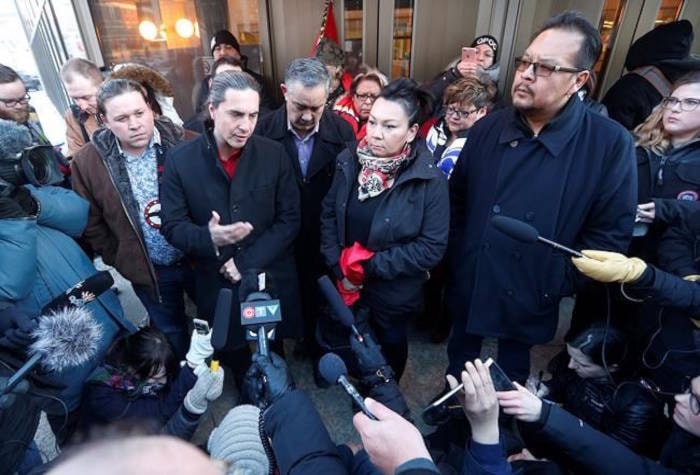Hundreds marched through the streets of Winnipeg a day after a jury acquitted a man accused of killing a 15-year-old Indigenous girl whose body, wrapped in a blanket and weighed down by rocks, was pulled from a river.
The three-block-long march in support of Tina Fontaine’s family began Friday in front of the courthouse and wound its way to the spot at the Red River where the teen’s body was found in August 2014.
Supporters carried signs reading No Justice No Peace, Justice for All and Love for Tina.
On Thursday, a jury found Raymond Cormier, 56, not guilty of second-degree murder.
“We did what we could to bring justice for my baby girl,” Thelma Favel, Tina’s great-aunt who raised her, told the marchers. “Tina, I know, is beside me right now and she’s looking at you and appreciating everything that you’re doing.”
Indigenous leaders speaking at the march reiterated that social services and the justice system are failing Indigenous youth. Fontaine was in government care and was staying at a hotel when she disappeared.
“This is 2018. Canada, you’ve got to wake up. You talk about reconciliation. Now’s the time to do it,” said Chief Derrick Henderson of the Sagkeeng First Nation which was Tina’s home.
Anishinaabe elder Chickadee Richard said Indigenous youth must be protected.
“Tina represents our babies and our babies are not safe out there,” she said. ”There’s monsters out there hurting our babies and I wonder when is this going to stop.”
There were also calls for Cormier to face other charges related to his relationship with Tina.
“He should have been charged … for at least rape and exploitation,” said Marilyn Courchene, a Sagkeeng councillor.
The Crown had argued that a possible motive for the killing was that Cormier had found out how old Tina was. He admitted on undercover police tapes that he had sex with the teen and was heard saying he bet Tina was killed because he found out she was only 15.
The defence had argued that the tapes were hard to hear, that the transcriptions could be wrong and that Cormier’s denial to police of any involvement was the real truth.
There was no DNA evidence linking him to Tina and experts could not determine how she died.
Scott Newman, a spokesman for the Criminal Defence Lawyers Association of Manitoba, said the jury came to a just conclusion.
“There were significant holes in the case that the Crown simply wasn’t able to close. It’s unfortunate that Mr. Cormier was held in custody and put on trial for a case that was as weak as this,” Newman said Friday.
He said it could have saved lawyers a lot of trouble if Cormier had had a preliminary hearing to determine whether there was enough evidence to proceed. Instead, the Crown sent him directly to trial.
Newman said he’s not surprised at the outrage the case has stirred.
“The focus really needs to be on … how do we make sure that this doesn’t happen again? How are we going to protect future Tina Fontaines from finding themselves in a similar position?”
David Milward, an associate professor of law at the University of Manitoba, called the acquittal an injustice.
He said juries usually convict when they hear confessionary statements such as the ones Cormier made, even if there are other gaps in the case.
Before the Cormier verdict, Milward said, he always advised aspiring defence lawyers in his classes to do their utmost to get such remarks excluded so a jury never hears them.
“Because once it goes in, you’re pretty much cooked,” he said.
“But now it’s almost like I’m tempted to tell the class … except when an Aboriginal person’s a victim, and then apparently you don’t have anything to worry about.’”
— With files from Lauren Krugel in Calgary
Bill Graveland, The Canadian Press
